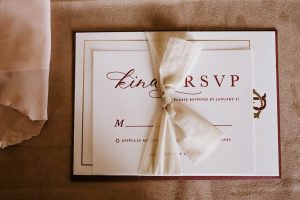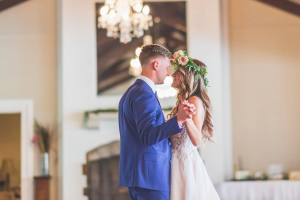Whether you’re a Christian, Muslim, or pagan, there’s always a way you can have a marriage ceremony that aligns with your beliefs. However, it can be devastating not to be aware of the marriage process you’re about to commit to, and as such, you need a breakdown of every step you’ll undergo.
Fortunately, this piece aims to uncover the order of wedding ceremony programs. From traditional to nonreligious ceremonies, there’s something for everyone for a successful marriage. So without further ado, let’s jump straight into it.
1. Traditional Wedding Ceremony Program
The order of a traditional wedding ceremony program is a well-established process that consists of various symbolic components to represent the union of the bride and groom.
The ceremony typically starts with a processional, where family members and the wedding party walk down the aisle and take their respective places.
The officiant then offers opening remarks and a welcome, followed by a reading or prayer. The exchange of vows and rings by the bride and groom takes place next, and the officiant pronounces them as married. Finally, the newlyweds’ kiss, and the wedding party exits the ceremony space.
Incorporating cultural and religious rituals is essential to a traditional wedding ceremony program. These rituals hold significant meaning and represent the bride and groom’s cultural or religious traditions.
The reception provides a platform for guests to celebrate the newlyweds, eat, drink, and dance. It often includes formal speeches, toasts, and traditional dances like the first dance between the bride and groom or the father-daughter dance.
2. Modern Wedding Ceremony Program
The modern wedding ceremony script differs from a traditional one as it focuses more on personalizing the ceremony and creating an experience tailored to the couple. It typically consists of the processional, welcome remarks by the officiant, and exchange of vows. The couple can decide whether to include readings, music, or any other ritual.
The couple completes the ceremony by exchanging rings and their first kiss as newlyweds. The following reception is often informal, focusing on celebrating the union. Music and dancing are encouraged, and guests of all ages can enjoy some fun. The couple typically serves food and drinks throughout the reception and any special activities they have prepared.
3. Jewish Wedding Ceremony Program
The Jewish wedding ceremony program is steeped in tradition and follows a specific order. It begins with the signing of the Ketubah, a Jewish marriage contract, followed by a Tisch ceremony where the couple receives blessings from their families and friends. The groom then wears a white robe, the kittel, and awaits the bride under the chuppah.
The exchange of rings takes place next in the Jewish wedding ceremony program. The groom recites a blessing before placing the wedding band on the bride’s finger. The couple then drinks from a cup of wine and recites the Sheva Brachot, the Seven Blessings, over the cup.
The groom then breaks a glass with his foot, symbolizing the destruction of the Temple in Jerusalem. The ceremony concludes with the rabbi reciting the final blessing as the newlyweds exit the chuppah.
4. Protestant Wedding Ceremony Program
The Protestant wedding ceremony program typically follows a structured order that reflects the religious significance of the event.
The ceremony begins with an intro, during which guests are seated, and the wedding party makes their entrance. The officiant then welcomes everyone and opens the ceremony with a prayer. This is followed by the declaration of intent, where the couple publicly declares their desire to marry each other.
Next in the Protestant wedding ceremony program is the exchange of vows and rings. The couple typically recites traditional wedding vows but may also choose to write their own. They then exchange rings to symbolize their love and commitment to each other. This is often followed by a reading or musical performance that reflects the couple’s faith and values.
Generally, people mainly do this marriage with the same religious affiliation who believe being a protestant is the best way to live. This makes it easy to implement the binding rules of the ceremony.
5. Catholic Wedding Ceremony Program
The Catholic wedding ceremony program has a long, meaningful tradition. It begins with the entrance of the wedding party and the opening prayer by the officiant.
The couple then declares their intent to marry each other before exchanging vows and rings to symbolize their love and commitment.
A reading or musical performance that reflects the couple’s faith and values typically follows the exchange of vows and rings. The ceremony concludes with the pronouncement of marriage and a final blessing. The newlyweds and the wedding party exit the ceremony venue, followed by the guests.
This is a perfect marriage for those who believe in the scripture and cannot go against it. On the other hand, the nonreligious ceremony is the exact opposite of the catholic ceremony. It allows you to tailor the event however you please without following certain guidelines.
6. Personal Friend As Officiant Wedding Ceremony Program
A personal friend as an officiant wedding ceremony program gives the couple a more personalized and unique wedding experience.
The ceremony typically begins with a welcome and introduction by the friend-officiant, followed by a reading or a musical performance that reflects the couple’s values and beliefs. The couple then exchanges vows and rings to symbolize their love and commitment.
The ceremony may also include meaningful rituals or traditions for the couple, such as lighting a unity candle or sharing a cup of wine. The friend-officiant can also guide and advise the couple on their new journey together. The ceremony concludes with the pronouncement of marriage and a final blessing.
A close acquaintance as an officiant in marriage ceremonies is an excellent choice for couples seeking a more personalized and one-of-a-kind wedding experience. The friend-officiant may create a more private and easygoing setting, making the couple feel more at ease.
The ceremony can suit the couple’s shared values and beliefs. Having a close acquaintance officiate the wedding ceremony program may make the couple’s and their guests’ wedding day more meaningful and unforgettable.
7. Non Religious Wedding Ceremony Script
Regarding nonreligious marriage ceremonies, you don’t need traditions and customs that tie a relationship. This is an excellent way for two adults to share their values and beliefs in the best way they deem fit.
So couples will have the full authority to have a tailor-made wedding ceremony to fit their requirements while not having to adhere to any tied rules. As such, there are numerous ways people have celebrated non-religious marriage ceremony that has brought them eternal and external joy.
Personal tales about the couple’s adventure together, heartfelt statements or readings, and symbolic traditions that symbolize their distinct ideals can all be included in the ceremony. The couple might also opt to include friends and family members in the wedding by having them narrate or execute funny melodies.
Moreover, holding a nonreligious ceremony provides the ultimate platform for guests from all walks of life, including those from different religious backgrounds, to celebrate the red letter day.
It establishes the tone for a polite and inclusive ceremony, with no compulsion to adhere to certain faith traditions. A non-religious wedding can still be dramatic and moving, focusing on the couple’s pure and unadulterated love.
Where do you find wedding ceremony scripts?
You can find wedding ceremony scripts online on websites such as WeddingWire, The Knot, and Pinterest. These resources provide sample wedding scripts for traditional, religious, and non-religious ceremonies.
Additionally, there are independent websites specifically dedicated to providing wedding ceremony scripts. Such sites provide sample scripts for various wedding ceremonies, such as civil, secular, and interfaith.
You can also find books that provide an abundance of sample wedding ceremony scripts to choose from. While these resources can be a starting point, the couple should personalize their wedding ceremony script to reflect their values and beliefs.
Conclusion
Be carefully following the guidelines and implementing them keenly, you’ll have the perfect wedding. So try them out today for positive results.
If you’re finding it hard to choose the right gift to give your bride or groom in your upcoming wedding ceremony, we’ve got you covered. We have a variety of unique wedding gifts at our online store. At Callie, we can customize jewelry and other gifts to match your liking. Check us out today!




